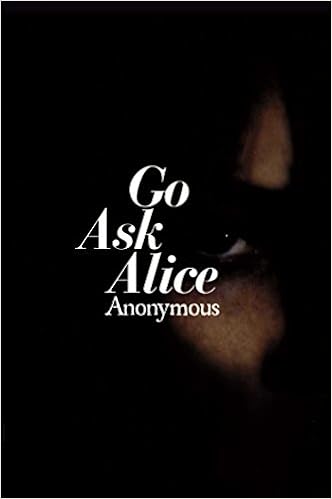
http://ecx.images-amazon.com/images/I/31gV3KeEqqL._SX330_BO1,204,203,200_.jpg
Bibliographic Information:
Go Ask Alice By Anonymous
(Beatrice Sparks)
ISBN: 0-671-66458-1
1971 Simon&Schuster, New York, NY
Plot Summary:
Go Ask Alice is
packaged as the diary of a young girl in the late 1960s, early 1970s teen
culture. The book begins with Alice promising to confide in her diary
everything in her life. Alice begins to work on losing weight, to make herself
more attractive for the boy she likes. She seriously limits her food intake
until she has lost almost all the weight she thinks she needs to lose to be
loveable.
Later, Alice’s father
finds out that he’s gotten a great job at a University and they are going to
have to move. Alice vows to be thin and perfect when she arrives at her new
school. Things do not turn out as perfect as she thought they would and Alice
turns to food for comfort and gains weight. Alice’s parents promise that she
can spend her summer with her grandparents, in her old home town, so she again
tries to lose weight.
While Alice is staying
with her grandparents, she is slipped LSD at a party and the world of drugs
opens up to her. Alice goes back and forth over wanting drugs and wanting to
quit drugs. She begins having sex, but only when she’s high.
After returning back to
the college town where her parents live, Alice stumbles into the drug culture
there. She begins pushing drugs and sleeping with her dealer. Their
relationship goes sour and she chooses to run away with another girl.
Alice has periods of
sobriety and relapse and suffers social consequences of getting clean before
she is finally sent away to rehab. In the end, Alice promises her diary that
she will stay clean.
Critical Evaluation:
This story is written
as if it is the diary of an addicted young girl. Right near the beginning,
there is foreshadowing of her problems when she attaches acceptance to being
thin and starves herself to achieve control. When control is taken from her and
she is drugged, she sees it as her choice to continue taking drugs or not.
Alice believes that she chooses to get high because it feels good.
The dark portions of the
diary, when Alice is homeless and dirty, are less coherent and the writing
style breaks down, presumably to express the problems with a drug addled mind.
The reader can tell when Alice’s thoughts are clearer because the writing is
more precise. This shows when Alice goes to rehab and then chooses to start a
new diary.
Another incident of
foreshadowing is when Alice gets a babysitting job and the previous babysitter
shows up, high and demanding. Later on, Alice’s sober world falls apart at that
babysitting job. It is no surprise that the young woman who lost the
babysitting job to Alice testifies against her.
The imagery in the book
of the euphoria and pain involved in drug addiction is graphic. This is serious
stuff, written for older teens.
Reader’s Annotation:
A young girl chronicles her decent into sever drug addiction and tries to claw her way back out.
Author Information:
Beatrice Sparks was an
American therapist and Mormon youth counselor who was known for producing books
purporting to be the 'real diaries' of troubled teenagers. The books deal with
topical issues such as drug abuse, Satanism, teenage pregnancy or AIDS, and are
presented as cautionary tales. Although Sparks always presented herself as
merely the discoverer and editor of the diaries, records at the U.S. Copyright
Office show that in fact she was listed as the sole author for all but two of
them.
Sparks began working
with teenagers in 1955, after attending the University of California at Los
Angeles and Brigham Young University. She has worked as a music therapist at
Utah State Mental Hospital and taught continuing education courses at BYU.
Critics have called the
precise extent of Sparks' qualifications and experience into question. The
editorial credit on some of the diaries published by Sparks identifies her as
"Dr Beatrice Sparks, PhD". However, when journalist Aileen Pace
Nilsen interviewed Sparks for School Library Journal in 1979, she was unable to
find any confirmation of where or when Sparks earned her doctorate. Nilsen also
wrote that Sparks was "vague about specifics" when asked about her
counseling qualifications and professional experience.
Sparks said that her
experience working with troubled adolescents made her want to produce
cautionary tales that would keep other teens from falling into the same traps.
Her first work, Go Ask Alice, was published under the byline 'Anonymous' in
1971.
Retrieved from https://www.goodreads.com/author/show/69007.Beatrice_Sparks
on 7/26/2015
Genre(s):
Realistic Fiction
Curriculum Ties:
Drug Abuse
Booktalk Ideas:
This is a great opening for booktalks on diaries, drug use, runaways, and addiction.
Reading level: grade 7+
Interest age: 13+
Challenge Issues:
Drug use and sexuality are prominent in this book.
Why I chose this book:
I chose this book
because it is a historically best-selling book that examines teenage
relationships with drugs, sex, family, and friends. This perspective is
alarming and grabs the reader’s attention.
No comments:
Post a Comment